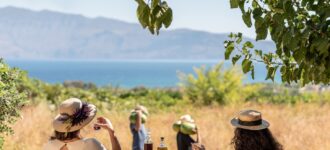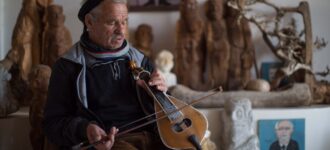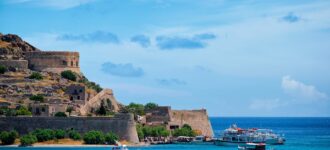
You will find Episkopi, a traditional Cretan village in a beguiling natural setting, about eighteen kilometers southeast of the Cretan capital Heraklion. It sits about 350 above sea level on a hill surrounded by vineyards and olive groves. Alongside herding, viticulture and olive growing are the main agricultural practices in this area – so, if you visit Episkopi, do taste the local wine and olive oil.
Episkopi’s history stretches back to the Minoan era, as archaeological finds attest. Archaeologists even unearthed a Minoan quarry in the area. A lot has changed in Episkopi through the ages, and today the visitor can appreciate the Byzantine heritage of the village preserved as monumental churches.
The village got its name around the late 900s when Hersonissos’ bishopric transferred here at the end of the Arabic domination (824-961). Hence, translated into English, Episkopi means bishopric or diocese.
There are several noteworthy churches from the Byzantine era to see when you visit Episkopi:
- Panagia Kera Limniotissa is an 11th-century conventual church that belonged to the Agarathos Monastery, one of Crete island’s oldest abbeys. It is a domed cross-in-square church made of stone dedicated to the Virgin Mary. Time left its mark on the church, which had rich murals in the past. You can still admire some of the paintings today, albeit partially preserved.
- Agios Ioannis Prodromos is a church dedicated to St. Joan the Baptist. It dates from the 14th century, and it stands in Episkopi just south of Meidani Square. The single-nave barrel-vault church doesn’t look like much from the exterior, but it has beautiful frescoes inside. Some of the most notable scenes include St. John the Baptist Praying, the Ascension of Jesus, and the Myrrh-Bearing Women at the tomb of Christ.
- The Church of Michail Archangelos stands across the village town hall. It dates from the 14th century and is a single-nave barrel-vault church. It is believed that the church belonged to a graveyard once. Several tombs were found in its courtyard, and the iconography of the interior frescoes confirm this hypothesis.
- Agia Paraskevi is a single-nave barrel-vault church from the 15th Dedicated to Saint Paraskevi of Rome, the temple stands south of Meidani Square in Agia Paraskevi square. Erected during the Venetian rule of Crete, the church preserves a wealth of relics of the time, including architecture with elaborate interior characteristics. Many of the frescoes are of a more recent date. The church underwent renovations in the 1960s and 1999.
Besides the churches from the Byzantine period, you must visit the village’s parish church, Agios Minas – Kimisi Theotokou (St. Minas – The Assumption of Mary). This two-nave, barrel-vault church dates from 1882 – 1884. One nave is dedicated to the Assumption of Mary and the other to St. Minas; hence, the church has two celebrations: August 15 for Virgin Mary, and the other on November 11 for St. Minas. The church dominates the central Meidani Square of Episkopi. Enter to see the temple’s splendid marble iconostasis with all its valuable icons and experience peace and sacred characteristic to all Cretan churches.
You don’t have to be religious to enjoy these monuments. They have architectural, cultural, and artistic value. Stroll around Episkopi to observe the architecture of the Cretan homes too. The stop for a bite to eat at one of the local tavernas that serve traditional fare with a strong focus on meats and shared dishes.
Summers, you can catch an outdoor event in the village park, Panagiotakis, where you can find a theatre and a playground for the little ones.
Don’t leave Episkopi without a visit to the Argirakio War Ethnological Museum. This is a private institution, founded in 1994 by Michalis Argirakis to honor his parents, Ioannis and Kalliopi Argirakis, martyrs in the Cretan fight for freedom in World War II. The museum’s permanent exhibition showcases photographs, documents, and artifacts from the time, focusing on the Cretan movement during World War II and the Great Resistance following the war. The museum has a beautiful outdoor area, with trees shading cannons, trucks, and other military vehicles and weapons. Please note that the founder passed away in 2011, and the museum can now be seen only by appointment with the current managers.





